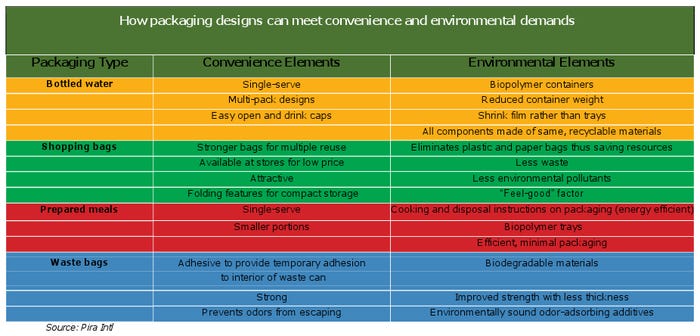The future of sustainable packaging: Convenience versus the environment
January 30, 2014
Consumer awareness of environmental issues and new material developments are the most important drivers in the development of sustainable packaging, according to a new industry poll.
Pira Intl., a worldwide authority on the packaging supply chains, conducted a survey of key players across the global packaging value chain. Seventy-nine percent of respondents rated "Increased exposure of consumers to environmental issues" and "advances in materials technology" as either a growth driver or major growth driver.
The packaging industry cannot help but become the sustainability focal point and primary benchmark for other industries. Not only is packaging a resource-intensive sector in an increasingly resource-constrained world, but tons of packaging waste are ending up in landfills daily. However, this challenge provides an opportunity to gain a competitive advantage through the development of a sustainability strategy without sacrificing consumer needs.
Making packaging friendly to the environment often conflicts with the traditional functions of packaging and more specifically with the consumers' demands for convenience.
To understand the impact of this important trend, the Pira study explores the market for sustainable packaging and the conflict between the convenience and the environment. The research identifies a range of important factors that suggest a greater interest in the sustainability agenda by the business world. Other factors, however, drive the consumer's choice when it comes to making a buying decision.
According to Pira, for consumers, packaging represents convenience, safety and comfort. For businesses, packaging represents profits and survival. The gap between consumers' ethical attitude and their purchasing decisions concerning ecological products is important to the packaging industry.
The main reasons for this gap are:
• A lack of communication and understanding regarding the meaning of sustainability
• Ambiguous promotions regarding these products and the abundance of "green-washed" products (those making false or misleading claims about environmental aspects)
• Suspicion that sustainable packaging will result in a higher priced product or a product that has less protection and function than before
• When asked what makes packaging environmentally friendly, shoppers worldwide consistently offer a one-word answer-recycling.
Packaging producers and consumers often judge environmental friendliness from different information sources, so there are numerous opportunities for discrepancy. A unified vision of sustainable packaging that both the industry and consumers can agree upon is needed.
New packaging designs using environmentally friendly materials and processes are important to the concept of sustainability, but protecting the product from damage or spoilage may have a far greater environmental impact.
According to the study, the factors that must be considered under the umbrella of sustainability are:
• Materials
• Overall energy use and transport
• Packaging waste minimization
• Reuse and source reduction
• Recycling
• Biodegradability and composting
• Waste-to-energy conversion
• Retail and consumer value.
In the future, Pira expects the environmental optimization of packaging will be conducted by more educated and environmentally conscious people as well as by computer programs specifically designed for the task.
The Pira study, "Future of Sustainable Packaging to 2020: Convenience versus the Environment," is available for purchase. For more information, contact Stephen Hill at +44 1372 802 025, [email protected]

Jan. 2011 Go Green
About the Author(s)
You May Also Like


